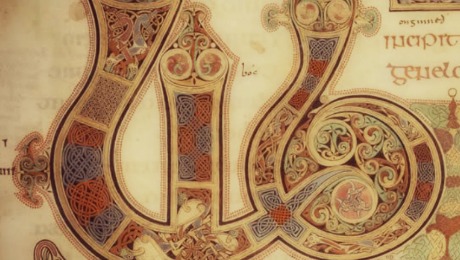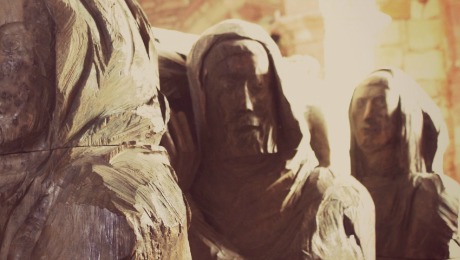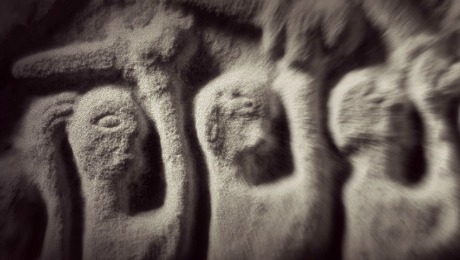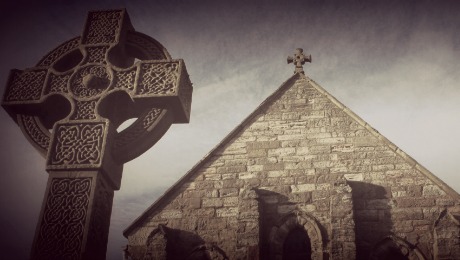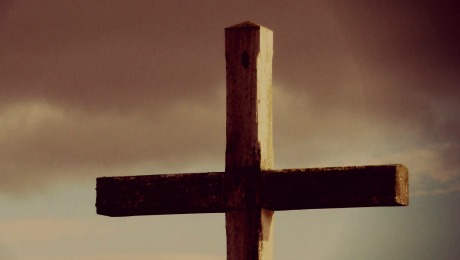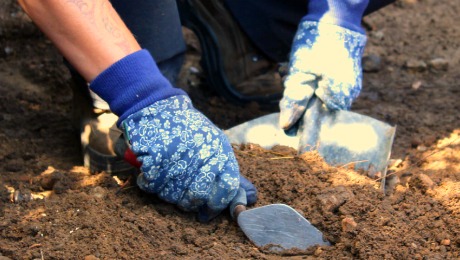Life for Lindisfarne’s early medieval monks was certainly tough. Their lives were ruled by prayer bells that rang from dawn to dusk. They farmed and fished to support themselves. From their workshops they produced illuminated manuscripts to adorn churches across Europe. Their monastery was more than a destination for pilgrims, or an isolated retreat; they were also busy making history.
The monks and their tenants farmed the island and its large estates on the mainland. They grew wheat, which needed storing, threshing and grinding to make bread. They had large herds of cattle supplying milk for cheese and butter, meat and leather. In fact, the outer parts of the monastery, with its byres and barns, probably appeared more like a farm than a religious centre.
The workshops
Lindisfarne’s workshops weren’t just for supplying the island’s daily bread; they were where the monks also produced opulent works of art to adorn the altars of Lindisfarne, and churches across early Medieval Britain and beyond.
Skilled metal and leatherworkers crafted beautiful objects, such as reliquaries, croziers, and elaborate vessels. But of all the art produced, the Lindisfarne Gospels are probably the most famous.
They too would have required skilled workers and purpose-built buildings to create them. The holy text was written on parchment made from carefully prepared calf-skin. Specialists produced the inks and pigments, scribes and illustrators would have worked on the gospel pages.
The Lindisfarne Gospels
The Lindisfarne Gospels are one of the great works of art of the early medieval world. Treasured by the island monks, this illuminated manuscript was more than a luxury holy book; it was holy relic, treated with nearly the same importance as the remains of Cuthbert himself. In fact, when most of the monks fled the island in the 9th century, they took the Gospels with them.
The Lindisfarne Gospels were probably displayed in pride of place on the altar in the main church. Their complex illustrations were no doubt mirrored in other objects in the church, such as wall hangings and vestments.
Creating such a beautiful book would have been a huge investment – for a start, it required over 200 calf skins to make the vellum pages alone. Not surprisingly illuminated gospel books like this were amongst the most prized possessions of early medieval monasteries, often given as gifts to important kings and churchmen.
The Cult of St Cuthbert, according to the Venerable Bede
Lindisfarne wasn’t only a centre of production; it traded in pilgrimage and personality too. Not long after Cuthbert arrived on the island, he was being celebrated as a miracle worker.
Cuthbert has been described as one of Britain’s most popular medieval saints, who quickly gained a reputation for great holiness . He travelled widely around the region tending to his flock, but when he eventually tried to retire and become a hermit, his flock did not let him rest – they demanded his return and made him Bishop.
Uncomfortable with his power, he once again left the island to become a hermit, this time on Inner Farne, where he eventually died in AD687. His popularity was such that his flock still would not let him rest.
His remains were brought back to Lindisfarne and buried next to the high altar in the main church. His body was exhumed 10 years later and this time placed in a shrine. And so the cult of St Cuthbert began.
Miracles were recorded at the shrine by Bede – the most prolific Northumbrian writer of the time – and soon, people were coming to Lindisfarne from far and wide to visit the relics of Cuthbert and the many other saints associated with the monastery. In order to provide a home fit for a saint, the old wooden church was reconstructed in stone.
Monk factory and religious powerhouse
During its heyday, the monastery was a hive of religious activity, with mass celebrated regularly in all the churches and chapels. Pilgrims thronged to the main church, to see the relics of Cuthbert and other Lindisfarne saints like Aidan and Finan. There are records of other churches too, including the so-called ‘Green Church’ which lay outside the main enclosure and was dedicated for the use of women. Visitors may even have processed around the island, stopping off at the island’s many holy sites, like the cross-carved boulder that still lies by the steep ramparts of Lindisfarne Castle.
Holy Island was also the centre of a network of other religious houses that looked to Lindisfarne as their mother-house. As well as producing food, artwork and saints, Lindisfarne also kept its daughter sites supplied with monks, holy relics, carved stone crosses and memorials, who probably offered agricultural produce in return.
Reaching beyond Northumbria, Lindisfarne was known as a centre of artistic production, blending Celtic, Germanic and Mediterranean styles, and with close links to the kings of Northumbria, who were often the most powerful kings in Britain.
